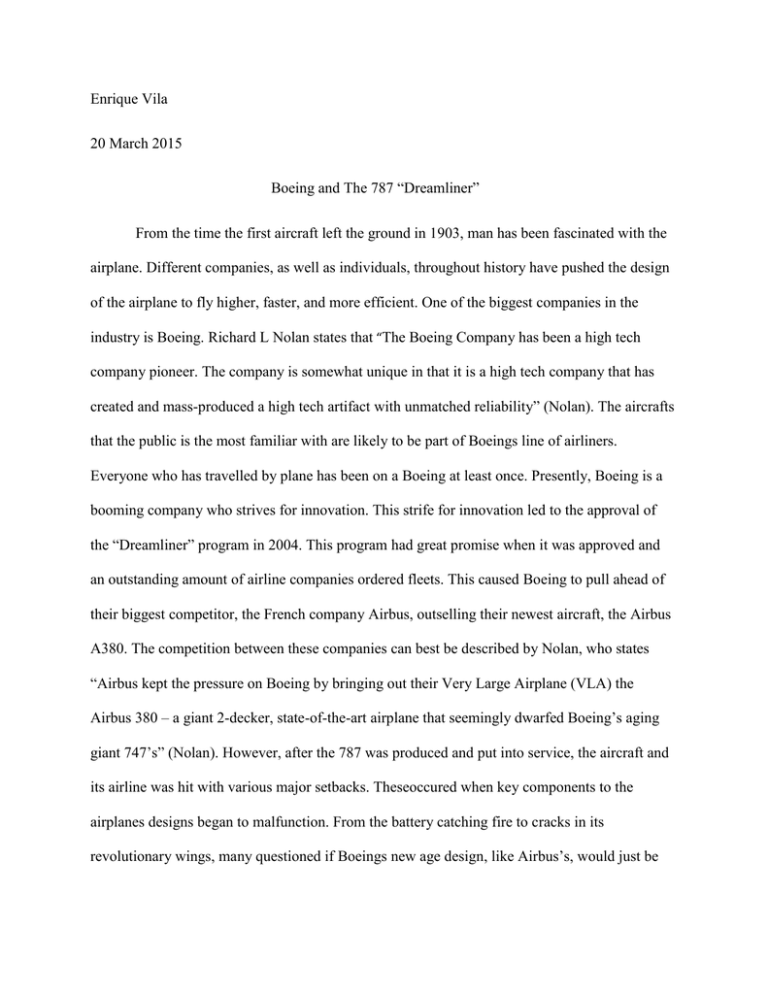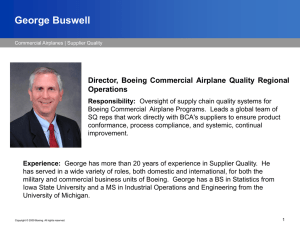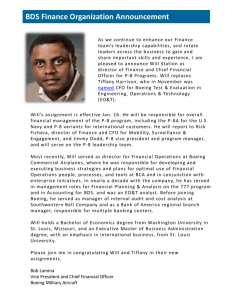Research paper
advertisement

Enrique Vila 20 March 2015 Boeing and The 787 “Dreamliner” From the time the first aircraft left the ground in 1903, man has been fascinated with the airplane. Different companies, as well as individuals, throughout history have pushed the design of the airplane to fly higher, faster, and more efficient. One of the biggest companies in the industry is Boeing. Richard L Nolan states that “The Boeing Company has been a high tech company pioneer. The company is somewhat unique in that it is a high tech company that has created and mass-produced a high tech artifact with unmatched reliability” (Nolan). The aircrafts that the public is the most familiar with are likely to be part of Boeings line of airliners. Everyone who has travelled by plane has been on a Boeing at least once. Presently, Boeing is a booming company who strives for innovation. This strife for innovation led to the approval of the “Dreamliner” program in 2004. This program had great promise when it was approved and an outstanding amount of airline companies ordered fleets. This caused Boeing to pull ahead of their biggest competitor, the French company Airbus, outselling their newest aircraft, the Airbus A380. The competition between these companies can best be described by Nolan, who states “Airbus kept the pressure on Boeing by bringing out their Very Large Airplane (VLA) the Airbus 380 – a giant 2-decker, state-of-the-art airplane that seemingly dwarfed Boeing’s aging giant 747’s” (Nolan). However, after the 787 was produced and put into service, the aircraft and its airline was hit with various major setbacks. Theseoccured when key components to the airplanes designs began to malfunction. From the battery catching fire to cracks in its revolutionary wings, many questioned if Boeings new age design, like Airbus’s, would just be another failure waiting to happen. Like many, I too have the same question. Is the Boeing 787 a “game changing” design, or is it another failure that Boeing will sustain? The Boeing Company is a widely known name in the aircraft industry today, with its reliable and technologically advanced airliners it has become the preferred choice for many airline fleets around the world. Their reputation started in World War II when the company produced a large quantity of planes for United States Air force. One of the more famous planes from the war is the Boeing B29 which delivered the two atomic bombs to Hiroshima and Nagasaki, Japan, which ultimately ended the war. From that point on, Boeing has pushed for innovation in their aircrafts. Currently, Boeing produces a large amount of aircrafts for some of the world’s biggest airline companies, such as American Airlines, British Airways and many more. Their latest innovative design, the Boeing 787 “Dreamliner”, has pushed the company farther up the ranks in the industry. People, like Nolan, have said that it is an “Industry gamechanger”. The 787 Dreamliner is a design that is truly groundbreaking and has since changed the way airplanes are constructed and designed. The goal of the Dreamliner program was to create a medium sized aircraft that could travel the same distances and that was more efficient than the larger aircrafts. They accomplished this by using new, more advanced technologies and design components that had not yet been used in previous aircraft designs. In these new designs, composites were used instead of aluminum to construct the skin of fuselage, wings, and other structural components. This allowed the aircraft to be lighter and more aerodynamic. The aircrafts hydraulic systems were also replaced for smaller electrical systems which provided less drag and allowed for a sleeker design to be used. Another revolutionary design feat was the wing flex design. This design allowed the wings to flex at a larger angle which is said to look like a bird midway flapping its wings. The flexing of the wing reduced drag on the aircraft. The 787 is said to use 20-30% less fuel and less emissions, while also traveling at speeds comparable to the fastest twin-aisle airplanes, the Mach 0.85. In an attempt to grab the markets attention, because of its economical design, Boing was able to market the aircraft at a much cheaper price. Nolan stated “The Dreamliner also embraced a bold global manufacturing scenario that would allow it to be priced similar to the price of a Boeing 767-Boeing’s earlier generation of commercial airplanes” (Nolan). More than 800 airlines ordered the 787 which made it the fastest selling commercial airplane in history. This was for most of the airlines because a majority of these airlines were experiencing difficult financial times due to competition in airfare prices, as well as the sheer number of airline companies. The Boeing 787 has three variations: the 787-8, the 787-9, and the 787-10. The 787-8 is able to hold 242 passengers and is able to travel 7,850 nautical miles. The 787-9 is able to hold 280 passengers, is able to travel 8,300 nautical miles, and is much larger than the 787-8. The 787-10, which is currently in development, is supposed to be able to hold 323 passengers, and will be able to travel 7,020 nautical miles, which is more than 90% of the world’s twin-aisle routes. The design of the 787 and its performance supports Boeings claim to “become a knowledge and resource-sharing company that excels in the design, manufacturing and support of commercial aircrafts, defense and space systems. That it would continue its global leadership in core competencies such as the integration of large, complex systems, with detailed customer knowledge and focus on operating lean and efficient systems.” (Nolan) and to create an aircraft that would change the face of the industry. Its design features along with the company’s reputation for producing reliable and technologically advanced aircraft, has made this aircraft a must have in the airline companies perspectives. The 787, on paper, has more than proven itself to be more efficient, faster, and able to travel farther than most of the larger airliners. The aircraft was thought to be able to take the industry by storm and cause the other manufacturers to run back to the drawing board. However like most advanced developments, when the 787 was put into service, problems and recalls were issued which caused many to question the new aircraft’s capabilities and if it was truly revolutionary or just another overambitious design. The 787 Dreamliner, according to Boeing, was their flagship for their new business strategy. This new airliner was predicted to take the curve in the market and put Boeing on top. Boeings ambition for this airliner was soon replaced with apprehension when the airliner was put into service. The aircraft suffered failures and different setbacks that forced the company to perform recalls and several investigations. One failure that caused a great disturbance and had occurred more than once was battery failure. On specific example was the story “Fire aboard Empty 787 Dreamliner Prompts Investigation” which gave a detailed account of the events that occurred on a Monday morning to the Japan airlines 787 on a Boston tarmac. The report states that an employee noticed smoke coming from the airliner. Soon thereafter, it was discovered that a fire had broken out in the plane and the fire department was called. Once the fire was put out, the National Transportation Safety Board (NTSB) launched an investigation to find the cause of the fire. It was discovered that the fire was caused by an explosion caused by the batteries that powered the aircrafts Auxiliary power unit. The chief of the Massport Fire Rescue Department, Bob Donahue, was quoted as saying “We did have a flare-up. There was a small explosion -- one of the batteries -- and we again went in with a secondary attack and were again able to knock it down” (Aaron Cooper, CNN). According to the article, this was not the first incident caused by the new airliner. The article states “In 2010, fire caused a 787 test flight to lose primary electrical power while flying from Yuma, Arizona, to Laredo, Texas” (Aaron Cooper, CNN). The article also stated that “Boeing said it was investigating the incident and noted it was too early to draw any parallels” (Aaron Cooper, CNN). It is also stated in a separate article that the “lithium-ion batteries overheated on two Dreamliners, prompting regulators to ground the worldwide fleet for more than three months while Boeing redesigned the battery system” (Scott et al.). An additional setback that the Dreamliner faced was the discovery of cracks on the wings of 40 787 Dreamliner’s during production. Although the problem did not pose any safety risks to the public, it still caused halt in the production process. These hindrances were detrimental to Boeing’s success. The author states “Boeing said the cracks, which also occurred on the larger 787-9 model currently undergoing flight tests, could delay by a few weeks the date when airlines can take delivery of their new planes” (Scott et al.). Boeing states that these cracks are not present in any of the aircraft in service. Although the article says that this is not a major problem, it still had a negative effect on the company reputation and the aircraft in production. A large number of the failures that had occurred over the history of the 787 were due to poor maintenance. Important systems like hydraulics, brakes, etc. caused major complications for the 787. One of the major systems that had been problem due to improper maintenance was the fuel system. Over the period of time that the 787 had been in service, fuel leaks had been a cause for grounding and recalling Dreamliner’s back to the factory. One of the most noted fuel leaks was the Norwegian Air flight from Bangkok to Oslo, which caused a delay of 19 hours, and took yet another 787 out of service which had to be sent back for repairs to a maintenance facility in Stockholm. The flight was reportedly stopped when passengers and crew noticed a huge leak coming from the wing. Sources say that “The leak was caused by a problem with a fuel valve” (Reuters). Reportedly this isn’t the only problem that the budget airline had with its fleet of Dreamliners. Norwegian Air had countless problems with these planes, a majority of the difficulties had to do with poor maintenance. One article states that “Norwegian has suffered regular maintenance issues with its three 787s, from the brakes to cockpit sensors to hydraulic pumps” (Bachman). These problems worsened the 787’s credibility and the Boeing name. The 787 had its share of both good and bad reviews. One thing that has been noticed, however, is that a portion of these articles have one similarity. When talking about the Dreamliner’s incidents, they refer to them as “teething issues” (Reuters). Much like a newborn child’s first set of teeth, the 787 is brand new. What this means is that because it has just been put in to service, it is bound to have problems that cause strife. The problems have had a detrimental impact on the 787 itself, but it does not render the aircraft useless. The breakthroughs that the aircraft has brought to the aerospace industry has pushed innovation further than any other aircraft manufactured in recent history. Its main rival, the Airbus A380, was very innovative when it was released in 2007. However, when the 787 was released in 2011, the design, innovative materials and technologies surpassed that of the A380. The Dreamliner accomplished the goals that were set when the program was approved in 2004. Even though these setbacks cost Boeing millions, Boeing can add this airliner to its history of innovative designs. Works Cited "787 Dreamliner." Boeing: About the 787 Family. Boeing. Web. 22 Mar. 2015. <http://www.boeing.com/commercial/787family/background.html>. Bachman, Justin. "Boeing 787 Dreamliners Disrupt Norwegian Air Shuttle's Operations." Bloomberg.com. Bloomberg. Web. 23 Apr. 2015. <http://www.bloomberg.com/bw/articles/2014-01-22/why-is-the-787-dreamliner-such-a-hasslefor-norwegian-air>. "Fire aboard Empty 787 Dreamliner Prompts Investigation - CNN.com." CNN. Cable News Network, 8 Jan. 2013. Web. 22 Mar. 2015. <http://www.cnn.com/2013/01/07/travel/dreamlinerfire/index.html>. “Hairline wing cracks discovered on Boeing 787 Dreamliner’s in production." Airguide Online 2014: General OneFile. Web. 22 Mar. 2015. Nolan, Richard L. "Ubiquitous IT: The Case of The Boeing 787 And Implications For Strategic IT Research." Journal Of Strategic Information Systems 21.20th Anniversary Special Issue (2012): 91-102. ScienceDirect. Web. 22 Mar. 2015. Scott, Alwyn, and Tim Hepher. "Boeing Reports Wing Cracks on 787 Dreamliners in Production." Reuters. Thomson Reuters, 7 Mar. 2014. Web. 23 Apr. 2015. <http://www.reuters.com/article/2014/03/07/us-boeing-cracks-idUSBREA261QG20140307>. "UPDATE 1-Fuel Leak on Boeing 787 Delays Norwegian Air Flight." Reuters. Thomson Reuters, 21 Jan. 2014. Web. 23 Apr. 2015. <http://www.reuters.com/article/2014/01/22/boeing787-norwegianidUSL2N0KW02320140122>.






